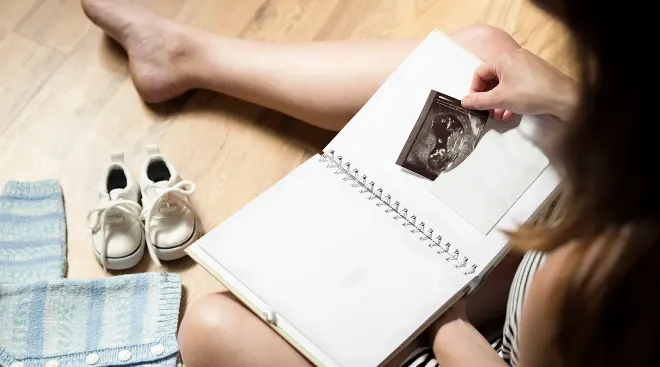- At this stage, it might feel like you’re all belly—and with good reason. Your uterus has grown to about 500 to 1,000 times its original size.
- Make sure you know the signs of labor. Braxton Hicks contractions will feel intense at this point; make sure they’re not getting stronger and more frequent. If they are, call your doctor.
- The Group B strep test will be happening in the next week or two. Your doctor will swab your vaginal area and rectum and have it tested for bacteria called Group B Strep. The bacteria is common, but can be harmful to baby. Don’t worry, if you’re positive, you’ll just be given intravenous antibiotics during labor to protect baby.
At 35 weeks, some moms-to-be feel like they have a ton of stuff left to do before baby’s arrival. Others can barely wait for baby to make their debut. Either way, try not to stress; baby will show up when they’re ready and won’t care if you haven’t checked every little detail off your list. As long as you’ve got a safe place for baby to sleep, some diapers and an infant car seat for the ride home, you’ve already got a bunch of baby’s basic needs taken care of.
Baby’s hearing is now fully developed, and your 35-week fetus responds best to high-pitched noises. If you’re having a boy, his testes might have fully descended at this point, and you may potentially be able to see this on a 35 weeks pregnant ultrasound. (Bet you hadn’t thought about that one!)
Your little one is putting on some weight right now, which may sound intimidating to Mom, but it’s really a good thing. Those extra pounds (or, more likely ounces) will help baby stay warm outside the womb.
At 35 weeks, your baby’s brain is continuing to grow. By now, it weighs about two-thirds of what it will at around 40 weeks. How neat is that?
How big is baby at 35 weeks?
At 35 weeks pregnant, baby is as big as a pineapple. Baby measures about between 17 and 18 inches from head to heel. From here on out, they won't get much longer but will keep plumping up. Your 35-week fetus now weighs about 5.5 to 6 pounds, and will put on a pound or more of baby fat before you meet them.
35 weeks pregnant is how many months?
Thirty-five weeks pregnant is eight months pregnant, although doctors refer to your stage in pregnancy by week, not month. Just about five more weeks left!
35 week ultrasound
Wondering if you’ll get an ultrasound this week? Probably not—unless you’re considered high risk. This week or next, you may have a Group B strep test. For it, your doctor will take a swab of your vaginal area and rectum and have it tested for bacteria called Group B Strep. This bacteria is common and isn’t going to make you sick, but it could be harmful to baby if they’re exposed to it at birth, so knowing whether you have it is important. If you do, you’ll be given antibiotics during the birth to prevent exposure, and that’s that. Easy peasy.
As you wrap up your eighth month, you’re probably feeling some of these 35 weeks pregnant symptoms:
Frequent urge to pee
Yup, your bladder is being pressed on by baby (or babies, if you’re 35 weeks pregnant with twins), who’s likely sitting pretty low in your pelvis, getting ready for birth. Don’t let the extra trips to the bathroom deter you from drinking lots of water, though—dehydration puts you at risk for preterm labor, so drink up.
Constipation
We’ve said it before and we’ll say it again: Make sure to get plenty of fiber in your diet. If you’ve tried everything and are still struggling with constipation, ask your doctor if it’s okay for you to take a fiber supplement or a stool softener.
Aches and pains in the hips and pelvis
These ouchies are continuing—and you may even be feeling a few new ones. While you’re dealing with discomfort, look on the bright side: It’s a sign your body is getting ready to deliver your baby. Yep, all of this pain actually has a purpose! Your ligaments are loosening so that baby can make their way out of your uterus and into the world.
Braxton Hicks contractions
At 35 weeks pregnant, you may have noticed an increase in the number of contractions you're having. It’s kind of crazy how hard your belly can get! Just keep an eye on those contractions; rest when you get them and drink lots of water.
Is it normal to be really tired at 35 weeks pregnant?
You are definitely not alone in feeling fatigued at 35 weeks! Your body’s aches and pains, your bursting bladder and your very active baby all make insomnia a very real possibility at this stage of your pregnancy. You may also be experiencing symptoms such as leg cramps or heartburn that can prevent you from sleeping soundly. Just try to get all the rest you can now—in a few weeks, it will be much harder to sleep with a new baby to love and care for!
Growing, growing, growing. Yup, baby and you. Now that you’ve reached 35 weeks pregnant, your uterus has grown to about 500 to 1,000 times its original size, a number that might sound exaggerated to everyone else—but to you, it probably feels more like a million. You can expect to gain about a half-pound each week until you give birth.
When you’re 35 weeks pregnant, it’s a good idea to review the signs of labor. You may think this is early, but about 8.4 percent of singleton moms give birth prematurely, while moms who are 35 weeks pregnant with twins are close to being considered full term at this point.
This is not a drill! Here are signs of actual, call-the-OB-and-grab-your-hospital-bag labor:
Water breaking
You’ll know your water has broken if you experience something that’s less like discharge and more like a flow of water. It can happen in a big gush (like in the movies) or in a slow trickle that just keeps coming.
Painful contractions
Those Braxton Hicks have nothing on real contractions. If you’re suddenly feeling pain in your 35 weeks pregnant belly or back instead of some mild tightness, it could be time.
Regular contractions
True contractions happen regularly and don’t stop—they get more frequent, and more painful. Your doctor will probably tell you at what point to call and let them know about your contractions. A good rule of thumb is to call when contractions are about five minutes apart for a first pregnancy. If it’s not your first, call earlier—more like when they’re 10 to 15 minutes apart—because those labors tend to be much shorter.
Unsure if any 35 weeks pregnant symptom could be a sign of labor? Always call the doctor just to be safe.
Can baby be born at 35 weeks and be healthy?
Yes! While it’s still a couple more weeks until baby reaches “early term” at 37 weeks, they can still be born now and be just as healthy in the long run as one born later. Don’t be surprised if your doctor wants to extend baby’s hospital stay a bit just to make sure all is well.
It's not too early to start organizing the pile of goods needed for your hospital (or birth center) stay!… Cluttering your labor and postpartum space will bring unnecessary stress, not to mention tripping hazards in darkened rooms. Think comfort, familiarity and necessities: your bed pillow, personal toiletries, stretchy clothes, special objects for labor focal points, phones/chargers, snacks, baby outfit, car seat. Channel your inner minimalist!
Feeling over it? We hear you. Don’t worry, your pregnancy journey will be over soon enough—and the reward will be worth it! In the meantime, here are some ways to stay busy this week.
Pack your hospital bag
If you haven’t done so already, it’s time to prepare for delivery. There are things you’ll need (insurance information, photo ID) and there are things that you’ll want (socks, comfortable clothes for the trip home). Here’s a checklist if you need ideas for what to pack.
Use your pregnancy pillow
At the 35-week mark, this pillow has probably been a lifesaver for you. It helps you maintain that ideal left-side sleeping position, and it also relieves pressure on your hips while you’re lying in bed.
Watch your water intake before bed
There’s not a whole lot you can do about your frequent trips to the bathroom—it’s just part of being 35 weeks pregnant. Up all night? Limit how much water you drink in the hour or two before you go to bed to reduce the number of middle-of-the-night wake ups.
Eat more salads
They’re a great way to get more fiber in your diet to prevent constipation. Start with spinach or kale, add some lentils or roasted chickpeas (or go fruit-forward with pears, berries or apples) and top with sesame seeds or chopped almonds—they’re all tasty fiber-rich foods.
Frequently Asked Questions
Is it safe to use a pregnancy sling for discomfort?
As baby grows during the final stretch of pregnancy, you may be feeling more and more aches and pains in your back and pelvis. To alleviate this pain, you can use a pregnancy sling (sometimes called a maternity support garment), which is designed to help support your belly, taking some of the pressure off your pelvis. These garments are safe to wear and can really help with discomfort when standing, walking or doing other physical activities. Pregnancy slings can also help with stability, as your center of gravity changes with your growing belly.
Why might my doctor recommend a biophysical profile?
A biophysical profile is a prenatal test that helps doctors monitor the health and well-being of a fetus during pregnancy. It’s usually recommended when a doctor wants to help you make informed decisions about the timing and management of your delivery. This test may be offered to someone with a high-risk pregnancy, hypertension, advanced maternal age, if you’re carrying multiples, if there’s concern about your amniotic fluid level, if you’re experienced decreased fetal movement or if you’re more than a week past your due date. This test includes an ultrasound evaluation to assess fetal breathing, movements, tone, amniotic fluid volume and fetal heart rate.
Can eating spicy food during pregnancy induce labor?
We’ve all heard about some of the myths about ways to trigger labor at home, like eating spicy foods. Unfortunately, this is mostly not true. That said, spicy foods might lead to an upset stomach, which can cause uterine irritation and contractions. However, these are rarely actual labor contractions, and they’ll settle down along with your stomach. In fact, depending on how pregnancy is affecting you, spicy foods may also result in significant heartburn, which just adds an extra layer of misery to the situation.
It’s important to note that even if the spicy food trick did work, you should not be trying to trigger labor at 35 weeks pregnant. Baby isn’t considered full-term until they’ve reached 37 weeks gestation, so going into labor at this point would result in a premature baby. If you’re struggling with pregnancy to the point where you’re considering at-home labor induction tricks, talk to your provider to see if they have any suggestions to help you manage the next five weeks.
Are there benefits or risks of perineal massage at week 35?
Perineal massages, for some pregnant women, can be beneficial. Some studies have found that beginning regular perineal massages at around 35 weeks of pregnancy can help increase the elasticity and flexibility of the perineal tissues, which may result in less tearing during vaginal delivery. Additionally, these massages can improve blood circulation which can promote healing and reduce discomfort. There is minimal risk to these massages (but you should always check with your provider before starting them). That said, they aren’t effective for everyone and there’s no way to predict who they will or won’t work for.
I thought I'd miss beer the most while pregnant, and while that was true, nothing compared to how much I missed sleeping on my stomach! I've been a stomach sleeper my whole life, and that first postpartum sleep on my belly in my own bed was heaven
Please note: The Bump and the materials and information it contains are not intended to, and do not constitute, medical or other health advice or diagnosis and should not be used as such. You should always consult with a qualified physician or health professional about your specific circumstances.
Proceedings of the National Academy of Sciences of the United States of America (PNAS), Side population in human uterine myometrium displays phenotypic and functional characteristics of myometrial stem cell](https://www.pnas.org/doi/10.1073/pnas.0704472104#),,) November 2007
American Pregnancy Association (APA), Uterus Size During Pregnancy
Smithsonian magazine, Comparing Apples and Oranges, November 2010
National Institutes of Health, Braxton Hicks Contractions, August 2023
American College of Obstetricians and Gynecologists (ACOG), Group B Strep and Pregnancy, September 2023
National Institutes of Health, Development of Fetal Hearing, September 1994
Harvard Medical School, Undescended Testicle (Cryptorchidism), July 2019
American Pregnancy Association (APA), 35 Weeks Pregnant
National Institutes of Health, Sonography 3rd Trimester and Placenta Assessment, Protocols, and Interpretation, June 2023
American College of Obstetricians and Gynecologists (ACOG), Group B Strep and Pregnancy, September 2023
Cleveland Clinic, Frequent Urination, April 2023
American Pregnancy Association (APA), Dehydration During Pregnancy
National Institutes of Health, High-Fiber Diet during Pregnancy Characterized by More Fruit and Vegetable Consumption, December 2020
Mayo Clinic, Is It Safe to Take Stool Softeners to Treat Pregnancy Constipation?, May 2022
Northwestern University Medicine, Staying Comfortable in the Third Trimester
Cleveland Clinic, Relaxin, October 2022
American Pregnancy Association (APA), Fatigue During Pregnancy
Mayo Clinic, What Causes Leg Cramps During Pregnancy, and Can They Be Prevented?, April 2023
Cleveland Clinic, Heartburn During Pregnancy, January 2021
National Institutes of Health, Total Amount and Pattern of Weight Gain: Physiologic and Maternal Determinants, 1990
Centers for Disease Control and Prevention (CDC), Exploring the Decline in the Singleton Preterm Birth Rate in the United States, 2019–2020, January 2022
National Institutes of Health, Timing of Birth for Women with a Twin Pregnancy at Term: a Randomized Controlled Trial, October 2010
March of Dimes, Contractions and Signs of Labor, December 2018
University of Utah, When Is It Safe to Deliver Your Baby?
Mount Sinai Hospitals, Premature Infant, October 2022
American Pregnancy Association (APA), Hospital Bag Checklist
Cleveland Clinic, Pregnancy and Bladder Control
Lamaze International, How to Make the Best Salad for Pregnancy, July 2018
Learn how we ensure the accuracy of our content through our editorial and medical review process.
Navigate forward to interact with the calendar and select a date. Press the question mark key to get the keyboard shortcuts for changing dates.
















































